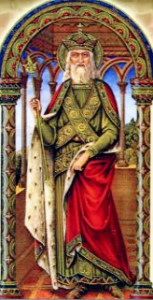Lives of the Saints
Our Models and Protectors
Spiritual Bouquet:
October 13

O.D.M. pinxit
Saint Edward III
King of England, Confessor
(1001-1066)
Saint Edward, son of King Ethelred, whose kingdom of England fell to the Danish invaders, was unexpectedly raised to the throne of England in 1041, at the age of forty years. God had shown Edward to a pious bishop in a vision, as England's King, anointed by Saint Peter: Behold the one who will be King through My favor; he will be cherished by heaven, agreeable to men, terrible to his enemies, loving to his subjects, very useful to the Church of God. The English people, tired of being governed by a foreign domination, decided in 1041 to reinstate the surviving son of their legitimate sovereign, and under the leadership of three noblemen, succeeded in crowning Edward on Easter Sunday of the year 1042. Edward had spent twenty-seven years of his forty in exile in Normandy, in the palace of his maternal uncle.
When he was raised to the throne, the virtues of his earlier years, simplicity, gentleness, humility and a tender charity, but above all his angelic purity, shone with new brightness. By a rare inspiration of God, though he married to content his nobles and people, he preserved perfect chastity in the wedded state. So little did he set his heart on riches, that three times when he saw a servant robbing his treasury, he let him escape, saying the poor man needed the gold more than he. He loved to stand at his palace-gate, speaking kindly to the poor beggars and lepers who crowded about him, and many of whom he healed of their diseases. The people rejoiced in having a Saint for their king.
Long wars had brought the kingdom to a sad state, but Edward's zeal and sanctity soon wrought a great change. His reign of twenty-four years was one of almost unbroken peace. He undertook only one war, which was victorious, to reinstate Malcolm, legitimate king of Scotland. The country grew prosperous, the ruined churches rose again under his hand, the weak lived secure, and for ages afterwards men spoke with affection of the laws of good Saint Edward. The holy king delighted in building and enriching churches; Westminster Abbey was his last and noblest work.
He had a particular devotion to the holy Apostles Saint Peter and Saint John the Evangelist, and had made a promise never to refuse an alms asked in the name of the latter. One day when he had no money with him, a poor man reached out his hand in the name of the Apostle, and the king gave him a valuable ring he was wearing. Some time later, Saint John appeared to two pilgrims returning from the Holy Land. He gave them a ring and said: Take it to the king; he gave it to me one day when I asked for an alms in the habit of a pilgrim. Tell him that in six months I will visit him and take him with me, to follow the unblemished Lamb. The King received it from them after hearing their relation of this incident, and broke into tears. And Edward did indeed die six months later, on January 5, 1066. Many miracles occurred at his tomb. In 1102 his body was exhumed and found intact and flexible, with its habits perfectly preserved also, appearing to be new. He was canonized in 1161 by Pope Alexander III.
Les Petits Bollandistes: Vies des Saints, by Msgr. Paul Guérin (Bloud et Barral: Paris, 1882), Vol. 12; Little Pictorial Lives of the Saints, a compilation based on Butler's Lives of the Saints and other sources by John Gilmary Shea (Benziger Brothers: New York, 1894).